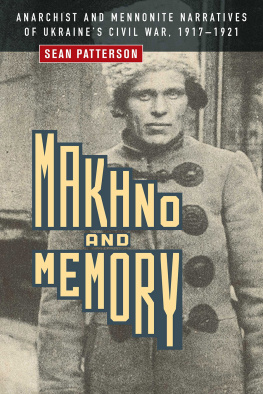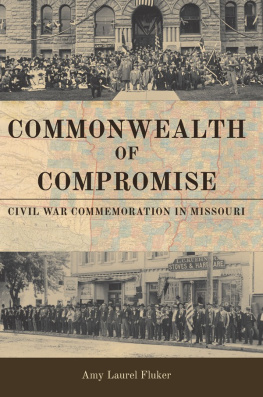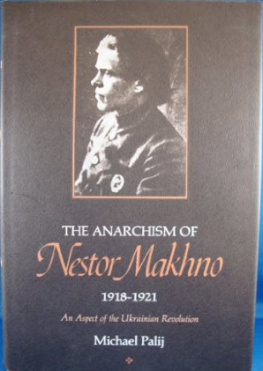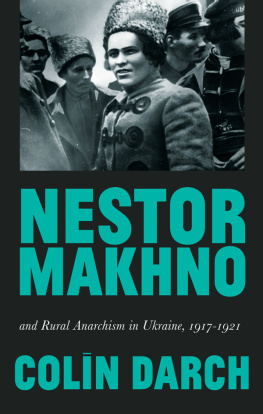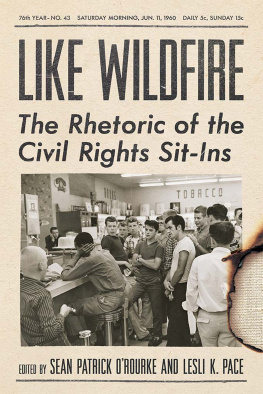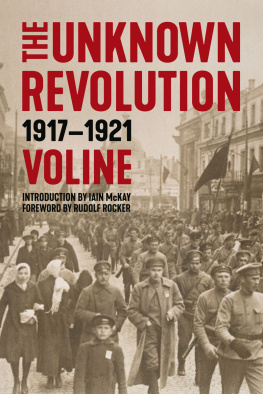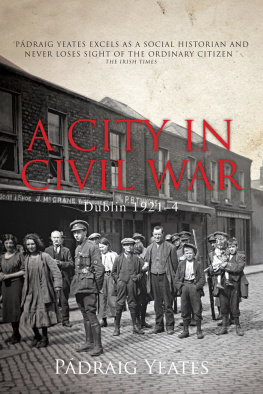Sean Patterson - Makhno and Memory: Anarchist and Mennonite Narratives in Ukraine’s Civil War, 1927-1921
Here you can read online Sean Patterson - Makhno and Memory: Anarchist and Mennonite Narratives in Ukraine’s Civil War, 1927-1921 full text of the book (entire story) in english for free. Download pdf and epub, get meaning, cover and reviews about this ebook. City: Winnipeg, year: 2020, publisher: University of Manitoba Press, genre: Politics. Description of the work, (preface) as well as reviews are available. Best literature library LitArk.com created for fans of good reading and offers a wide selection of genres:
Romance novel
Science fiction
Adventure
Detective
Science
History
Home and family
Prose
Art
Politics
Computer
Non-fiction
Religion
Business
Children
Humor
Choose a favorite category and find really read worthwhile books. Enjoy immersion in the world of imagination, feel the emotions of the characters or learn something new for yourself, make an fascinating discovery.
- Book:Makhno and Memory: Anarchist and Mennonite Narratives in Ukraine’s Civil War, 1927-1921
- Author:
- Publisher:University of Manitoba Press
- Genre:
- Year:2020
- City:Winnipeg
- Rating:3 / 5
- Favourites:Add to favourites
- Your mark:
- 60
- 1
- 2
- 3
- 4
- 5
Makhno and Memory: Anarchist and Mennonite Narratives in Ukraine’s Civil War, 1927-1921: summary, description and annotation
We offer to read an annotation, description, summary or preface (depends on what the author of the book "Makhno and Memory: Anarchist and Mennonite Narratives in Ukraine’s Civil War, 1927-1921" wrote himself). If you haven't found the necessary information about the book — write in the comments, we will try to find it.
Sean Patterson: author's other books
Who wrote Makhno and Memory: Anarchist and Mennonite Narratives in Ukraine’s Civil War, 1927-1921? Find out the surname, the name of the author of the book and a list of all author's works by series.
Makhno and Memory: Anarchist and Mennonite Narratives in Ukraine’s Civil War, 1927-1921 — read online for free the complete book (whole text) full work
Below is the text of the book, divided by pages. System saving the place of the last page read, allows you to conveniently read the book "Makhno and Memory: Anarchist and Mennonite Narratives in Ukraine’s Civil War, 1927-1921" online for free, without having to search again every time where you left off. Put a bookmark, and you can go to the page where you finished reading at any time.
Font size:
Interval:
Bookmark:

MAKHNO AND MEMORY
Sean Patterson
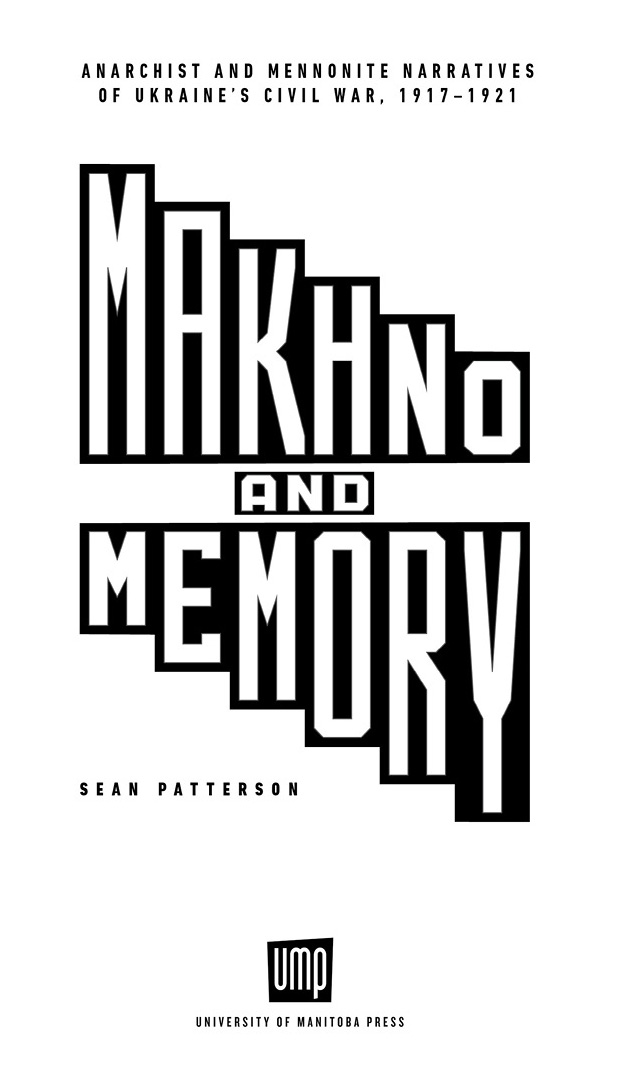
Makhno and Memory: Anarchist and Mennonite Narratives of Ukraines Civil War, 19171921
Sean Patterson 2020
24 23 22 21 20 1 2 3 4 5
All rights reserved. No part of this publication may be reproduced or transmitted in any form or by any means, or stored in a database and retrieval system in Canada, without the prior written permission of the publisher, or, in the case of photocopying or any other reprographic copying, a licence from Access Copyright, www.accesscopyright.ca, 1-800-893-5777.
University of Manitoba Press
Winnipeg, Manitoba, Canada
Treaty 1 Territory
uofmpress.ca
Cataloguing data available from Library and Archives Canada
ISBN 978-0-88755-838-2 (paper)
ISBN 978-0-88755-580-0 (pdf)
ISBN 978-0-88755-878-7 (epub)
ISBN 978-0-88755-878-8 (bound)
Cover image: Pavel Dybenko and Nestor Makhno. Alamy.com, ID E8FCYB.
Cover design by Frank Reimer
Interior design by Jess Koroscil
Map design by Weldon Hiebert
Printed in Canada
The University of Manitoba Press acknowledges the financial support for its publication program provided by the Government of Canada through the Canada Book Fund, the Canada Council for the Arts, the Manitoba Department of Sport, Culture, and Heritage, the Manitoba Arts Council, and the Manitoba Book Publishing Tax Credit.
Published with the generous support of the Canadian Foundation for Ukrainian Studies Scholarly Publication Support Program.
CONTENTS
A NOTE ON THE TEXT
Throughout this book, where an English version of a source is available I reference it. In all possible cases, I have checked these translations against the original language sources to ensure accuracy. I take full responsibility for all translations made by myself and any potential errors in this regard. Ukrainian toponyms are used in this book for all place names within Ukraines current borders. German spellings are used for Mennonite and German colonies. Russian toponyms have been retained only when they appear in the original source being quoted. A simplified Library of Congress system is used to transliterate Russian and Ukrainian. Soft signs, indicated by an apostrophe, have been removed in some cases. For example, Kuzmenko is rendered as Kuzmenko and Oleksandrivsk as Oleksandrivsk. I have also simplified Zaporizhzhia as Zaporizhia.
I use the word Ukraine throughout this book in a territorial sense. This is done to help orient the reader but does not imply Ukraine existed prior to the civil war period as an organized nation-state. However, the term was employed in a geographical sense as early as the twelfth century and regularly used from the fifteenth to eighteenth centuries by various powers in the region to describe the territories around the Dnipro River including those inhabited by the Zaporizhian Cossacks. At the same time, it is important to recognize that Ukrainian identity and Ukraines territorial boundaries were in a process of negotiation and were defined in a variety of ways by those who employed these terms. During the civil war, Ukraine existed as an organized state in the form of the Ukrainian Peoples Republicdeclared independent by the nationalist Central Rada in Kyiv in January 1918. The latter was briefly supplanted by a coup in April 1918, which led to the formation of the Ukrainian State, often referred to as the Hetmanate. A rival Kharkiv-based Ukrainian Soviet Republic was also declared in 1917 and served as a predecessor to the Ukrainian Soviet Socialist Republic.
LIST OF ILLUSTRATIONS
MAPS
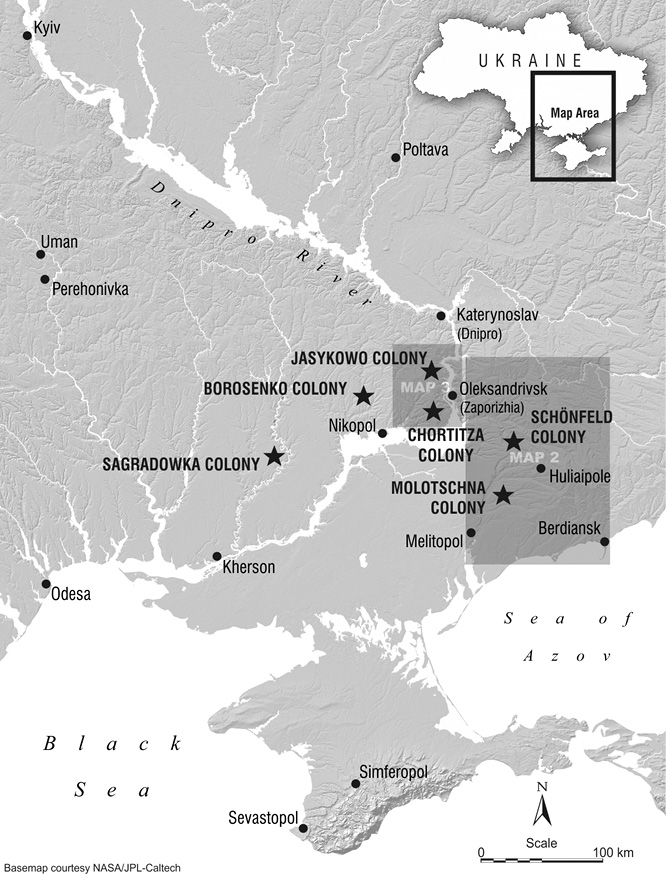
Map 1. Southern Ukraine in 1919.
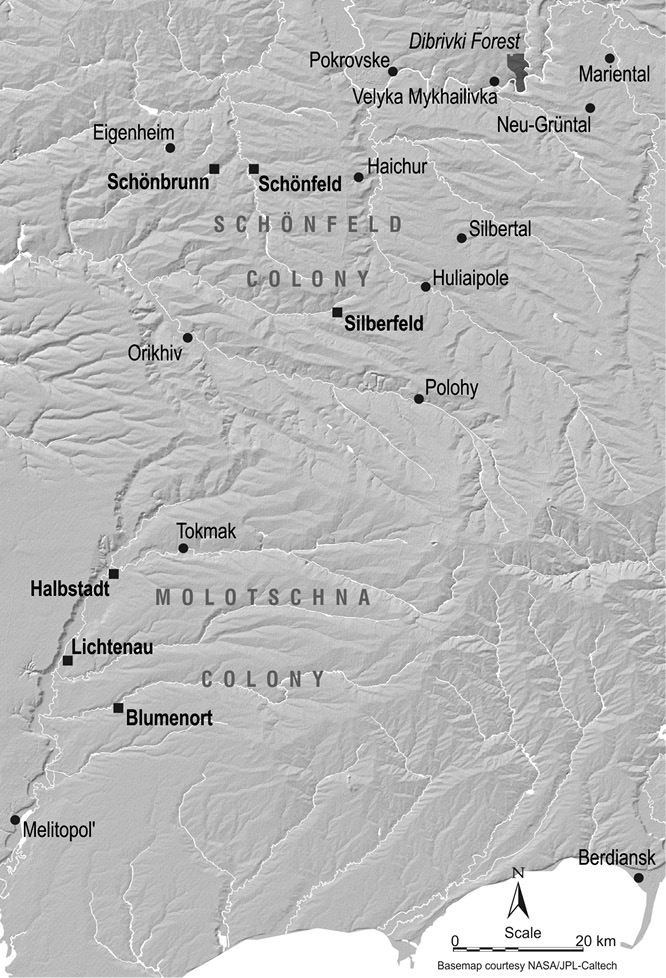
Map 2. Huliaipole and surrounding area.
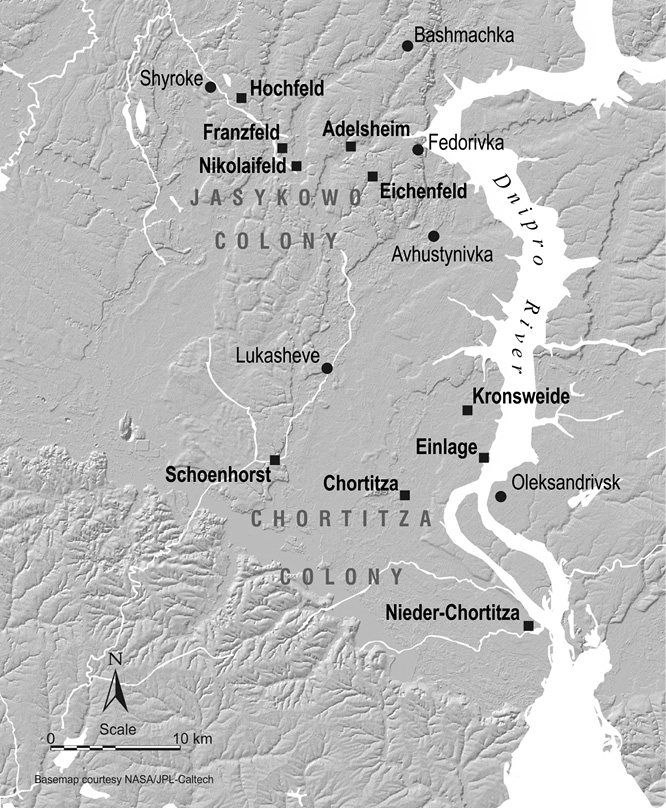
Map 3. Jasykowo and Chortitza colonies.
INTRODUCTION
A legend circulates among the locals of Huliaipole that the anarchist Nestor Makhno, upon abandoning his struggle and fleeing Ukraine, ordered a cache of loot to be buried in a secret location. The intention was to safeguard funds for a renewed battle against the Soviet regime in some imagined future, but Makhno never returned to his homeland and, according to local lore, the treasure remains buried to this day. Makhnos gold has not been confirmed as anything but a myth, but even if it did exist, what could be gained, besides the material riches, from its discovery? I believe the persistence of this story in the local collective mind relates to the belief that the materiality of historical artifacts can somehow make the past more substantial and present. If only metaphorically, discovering the gold would momentarily fulfill the promise of Makhnos return and all its attendant cultural meanings.
Historical writing similarly seeks to make concrete an ephemeral past, but, like Makhnos gold, it leaves us only with spectral traces trapped in documents, objects, landscapes, and receding voices. My research into Nestor Makhno and his movements conflict with the Mennonites of southern Ukraine has led me to confront a multitude of competing histories, memories, myths, and legends all jostling to assert their own unique perspective. It is a topic fraught with folklore, ideological battles, and radically divergent cultural memories in which fact and fiction often seamlessly blend. Through the prism of history, multiple Makhnos are conjured, each one shouting over the other.
This book seeks to tell a difficult story from two sides. The historical memory of Makhno is especially contested between todays Mennonites and the global anarchist community. To the former, Makhno is a sadistic character who perpetrated extreme violence against their parents and grandparents during the Russian Revolution and the ensuing civil war period in Ukraine. By contrast, many contemporary anarchists understand Makhno in heroic terms as the revolutionary leader of a movement that liberated workers and peasants from capitalist exploitation. Furthermore, Makhno is often celebrated in Ukraine as a regional hero. In his hometown, public statues, memorials, museum exhibits, and even a limited edition coin minted by Ukraines central bank, all hail Makhno as a populist hero. Mennonite and pro-Makhnovist assessments of history could not be further apart.
This book is about the origins of these two radically diverging narratives. Through memoirs, histories, diaries, and archived documents, each groups narrative representations of the Mennonite-Makhnovist conflict are explored. Of particular concern to this study is how each group constructed the other as an enemy and how each side legitimizedand protestedits use of violence. Central to these narratives is Nestor Makhno and their authors assessements of him as a hero or villain.
In certain ways, my personal relationship to the topic of Makhno embodies this narrative divide. As a young undergraduate I became fascinated by the philosophical writings of the Russian anarchist Peter Kropotkin. I was specifically attracted to Kropotkins theory of mutual aid as a critical factor in human and animal evolution. Kropotkin himself visited Canada in 1897 and wrote a largely positive report about Mennonites living in Manitobas so-called West Reserve. Kropotkins philosophy was also a major influence on Nestor Makhno. It is through this connection that I first encountered histories of the Makhnovist movement written by its participants Peter Arshinov and Volin. These histories emphasized the movement as a liberatory force championing direct democracy for peasants and workers and an egalitarian communal way of organizing society. However, when I returned home from university and told my friends and family about this fascinating movement I had read about, I learned of a completely different history.
Font size:
Interval:
Bookmark:
Similar books «Makhno and Memory: Anarchist and Mennonite Narratives in Ukraine’s Civil War, 1927-1921»
Look at similar books to Makhno and Memory: Anarchist and Mennonite Narratives in Ukraine’s Civil War, 1927-1921. We have selected literature similar in name and meaning in the hope of providing readers with more options to find new, interesting, not yet read works.
Discussion, reviews of the book Makhno and Memory: Anarchist and Mennonite Narratives in Ukraine’s Civil War, 1927-1921 and just readers' own opinions. Leave your comments, write what you think about the work, its meaning or the main characters. Specify what exactly you liked and what you didn't like, and why you think so.

